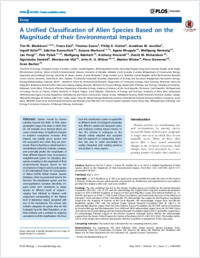A unified classification of alien species based on the magnitude of their environmental impacts
- Blackburn, Tim M. Institute of Zoology, Zoological Society of London, London, United Kingdom
- Essl, Franz Department of Conservation Biology, Vegetation and Landscape Ecology, University of Vienna, Vienna, Austria
- Evans, Thomas Imperial College London, Ascot, Berkshire, United Kingdom
- Hulme, Philip E. The Bio-Protection Research Centre, Lincoln University, Christchurch, New Zealand
- Jeschke, Jonathan M. Technische Universität München, Department of Ecology and Ecosystem Management, Restoration Ecology, Freising-Weihenstephan, Germany
- Kühn, Ingolf UFZ - Helmholtz Centre for Environmental Research, Department of Community Ecology, Halle, Germany
- Kumschick, Sabrina German Centre for Integrative Biodiversity Research (iDiv) Halle-Jena-Leipzig, Leipzig, Germany
- Marková, Zuzana Institute of Botany, Department of Invasion Ecology, Academy of Sciences of the Czech Republic, Průhonice, Czech Republic
- Mrugała, Agata Department of Ecology, Faculty of Science, Charles University in Prague, Prague, Czech Republic
- Nentwig, Wolfgang Institute of Ecology and Evolution, University of Bern, Bern, Switzerland
- Pergl, Jan Institute of Botany, Department of Invasion Ecology, Academy of Sciences of the Czech Republic, Průhonice, Czech Republic
- Pyšek, Petr Institute of Botany, Department of Invasion Ecology, Academy of Sciences of the Czech Republic, Průhonice, Czech Republic
- Rabitsch, Wolfgang Environment Agency Austria, Department of Biodiversity and Nature Conservation, Vienna, Austria
- Ricciardi, Anthony Redpath Museum, McGill University, Montreal, Quebec, Canada
- Richardson, David M. German Centre for Integrative Biodiversity Research (iDiv) Halle-Jena-Leipzig, Leipzig, Germany
- Sendek, Agnieszka UFZ - Helmholtz Centre for Environmental Research, Department of Community Ecology, Halle, Germany
- Vilà, Montserrat Estación Biológica de Doñana (EBD-CSIC), Seville, Spain
- Wilson, John R. U. South African National Biodiversity Institute, Kirstenbosch National Botanical Gardens, Claremont, South Africa
- Winte, Marten UFZ - Helmholtz Centre for Environmental Research, Department of Community Ecology, Halle, Germany
- Genovesi, Piero ISPRA, Institute for Environmental Protection and Research and Chair IUCN SSC Invasive Species Specialist Group, Rome, Italy
- Bacher, Sven Department of Biology, Unit Ecology & Evolution, University of Fribourg, Fribourg, Switzerland
-
06.05.2014
Published in:
- PLoS Biol. - 2014, vol. 12, no. 5, p. e1001850
English
Species moved by human activities beyond the limits of their native geographic ranges into areas in which they do not naturally occur (termed aliens) can cause a broad range of significant changes to recipient ecosystems; however, their impacts vary greatly across species and the ecosystems into which they are introduced. There is therefore a critical need for a standardised method to evaluate, compare, and eventually predict the magnitudes of these different impacts. Here, we propose a straightforward system for classifying alien species according to the magnitude of their environmental impacts, based on the mechanisms of impact used to code species in the International Union for Conservation of Nature (IUCN) Global Invasive Species Database, which are presented here for the first time. The classification system uses five semi-quantitative scenarios describing impacts under each mechanism to assign species to different levels of impact—ranging from Minimal to Massive—with assignment corresponding to the highest level of deleterious impact associated with any of the mechanisms. The scheme also includes categories for species that are Not Evaluated, have No Alien Population, or are Data Deficient, and a method for assigning uncertainty to all the classifications. We show how this classification system is applicable at different levels of ecological complexity and different spatial and temporal scales, and embraces existing impact metrics. In fact, the scheme is analogous to the already widely adopted and accepted Red List approach to categorising extinction risk, and so could conceivably be readily integrated with existing practices and policies in many regions
- Faculty
- Faculté des sciences et de médecine
- Department
- Département de Biologie
- Language
-
- English
- Classification
- Ecology and biodeversity
- License
- License undefined
- Identifiers
-
- RERO DOC 211336
- DOI 10.1371/journal.pbio.1001850
- Persistent URL
- https://folia.unifr.ch/unifr/documents/303698
Statistics
Document views: 108
File downloads:
- bac_uca.pdf: 120
